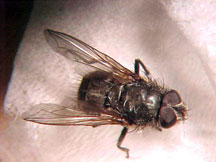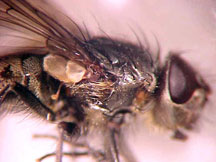Boxelder bugs, Asian lady beetles and cluster flies. Oh boy!
Editor’s note: This article is from the archives of the MSU Crop Advisory Team Alerts. Check the label of any pesticide referenced to ensure your use is included.
Finally the weather is warming, but warmer temps are bringing the bugs out. Already the telephone calls have started. People have bugs literally coming out of the wood work. Boxelder bugs, cluster flies and Asian lady beetles are awakening and looking to move out from their overwintering sites in our homes. At best, they will only clump up outside on the sun drenched sides of buildings. At worst, they will clump up inside our homes. And since they gained entry last fall, there is not much we can do about it now.
Most calls have been about boxelder bugs, but a few folks have also called to complain about cluster flies and the ever popular Asian lady beetles. These insects enter homes and other structures by squeezing
through cracks around windows and doors, loosely hung siding, soffit vents, louvers and other similar entry points. In heated structures, they may remain active during the winter months and may continually emerge from their hiding spots and find their way into living areas. Their presence is usually not appreciated by other residents of the home. Aside from being a tremendous annoyance, they are harmless; they do not feed or lay eggs during the winter months. They do not harm woolens, fur or feathers, nor do they infest foods in kitchen cupboards. Asian lady beetles may bite and boy, do they stink. Boxelder bugs and cluster flies are more considerate of their human hosts and keep pretty much to themselves. None of the three is known to transmit disease.
Cluster flies resemble the common house fly, but differ in that they have a patch of yellow hair under their wings. The cluster fly maggot is an internal parasite of earthworms and the flies are among the first to be active in the spring. They can be observed buzzing around yards just above the ground. They lay their eggs in cracks in the soil and the eggs hatch in about three days. Newly hatched maggots grab onto earthworms as they slither by and burrow into the worm to feed. Four to five weeks are required to complete a life cycle. The worm does not usually survive the experience. There are up to four generations of cluster flies in Michigan each year.
During the summer, boxelder bugs are black with red markings. They feed on the flowers and seed pods of female boxelder trees. The developing nymphs are bright red in color and are quite nomadic. They can be seen roaming about yards and gardens throughout the summer months. They are two generations of boxelder bugs each year in Michigan.
There is no easy remedy for these insects. It is practically impossible to kill enough of them to make a difference once they have found their way into wall voids, ceilings voids and attics. Once they’re in, they’re in and there is not much we can do about it. Sealing exterior cracks and holes with caulk may help reduce the number of bugs that find their way into older homes with clapboard siding. But no amount of caulk will help keep them out of newer homes with vinyl siding and soffits. Vinyl siding and soffits are “hung” when installed and not tightly nailed to allow the panels to expand and contract with changing temperatures. This allows insects to get around the panels and gain entry into the house.
Spraying the outside walls of homes with soapy water or a persistent insecticide, especially the south and west facing walls, when the insects begin to appear in the fall may help reduce the number entering the home. Another option is to hire a professional pest control operator to provide this service, but they can be expensive. And don’t expect miracles. Chances are you will continue to see flies even after “professional treatments.”



 Print
Print Email
Email







